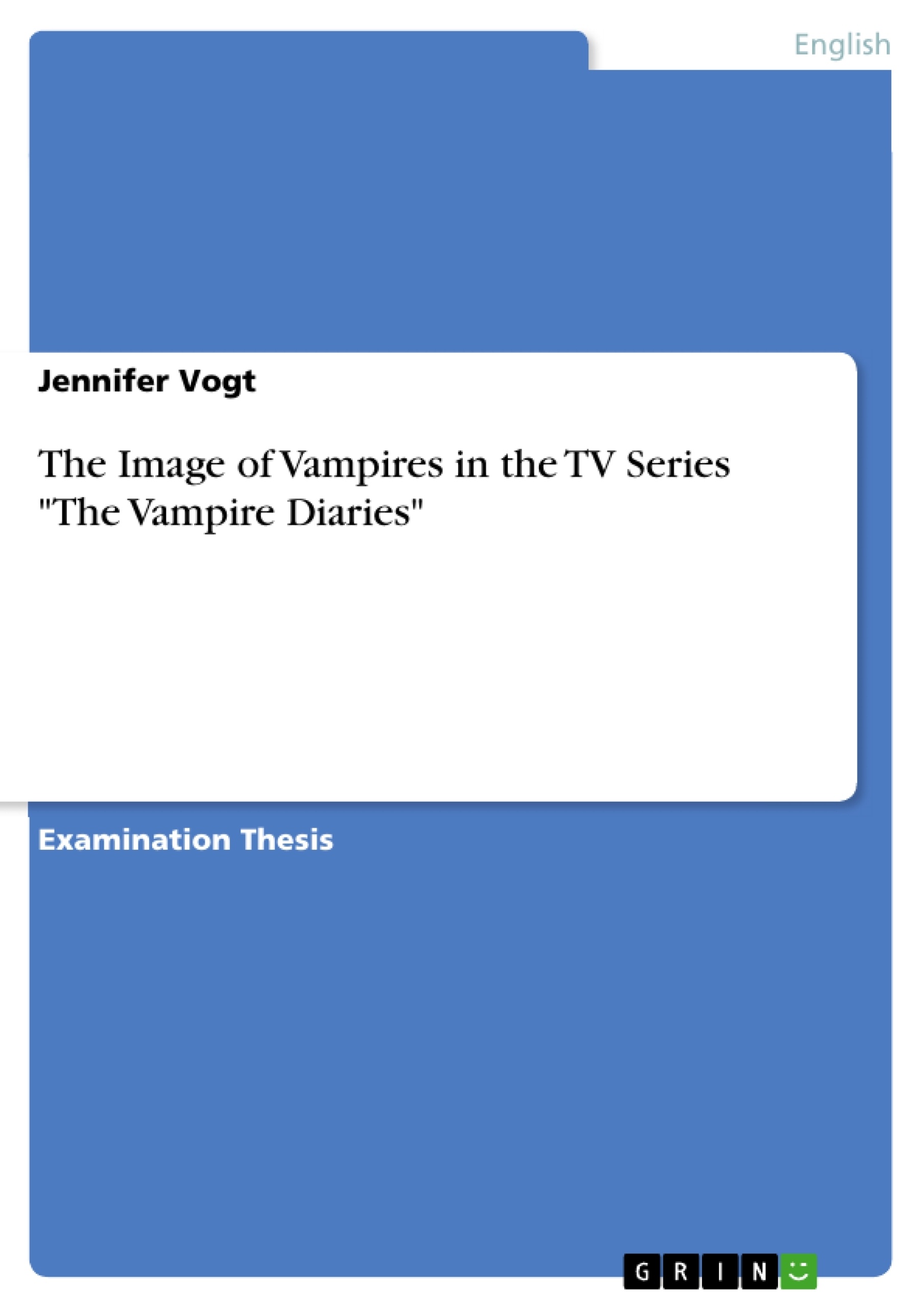
The Image of Vampires in the TV Series "The Vampire Diaries"
Examensarbeit, 2012
81 Seiten, Note: 2,0
Leseprobe
Table of Contents
- 1. Introduction
- 2. The Image of Vampires in Contemporary Fiction
- 2.1 From Evil Monsters to Sympathetic Creatures
- 2.2 Sympathetic Vampires
- 2.3 Humanised Vampires
- 2.4 Romantic Heroes
- 2.5 The Changing Role of Women
- 3. Plot and Important Characters of The Vampire Diaries
- 4. The Image of Vampires in The Vampire Diaries
- 4.1 Origins
- 4.2 Physical and Psychological Traits
- 4.3 Weaknesses and Death
- 4.4 Powers and Abilities
- 4.5 Socialisation
- 4.6 Relationships
- 4.6.1 Vampires and Humans
- 4.6.2 Vampires Among Themselves
Objectives and Key Themes
This thesis analyzes the portrayal of vampires in contemporary fiction, specifically focusing on the television series The Vampire Diaries. The objective is to demonstrate the evolution of the vampire image from purely demonic evil to a more complex, multifaceted supernatural being with both good and evil characteristics, closely intertwined with humanity. This analysis traces the changing representation of vampires throughout the 20th century and into the 21st.
- The evolution of the vampire image in contemporary fiction.
- The diverse types and personalities of contemporary vampires.
- The portrayal of vampires in The Vampire Diaries.
- The interplay of good and evil characteristics in the show's vampires.
- The relationship between vampires and humans within the context of The Vampire Diaries.
Chapter Summaries
1. Introduction: This introductory chapter establishes the enduring presence and evolving nature of the vampire archetype in modern media. It traces the vampire's origins in South East European folklore and its transformation through 19th and 20th-century literature and film, highlighting key works like The Vampyre, Carmilla, and Dracula. The chapter emphasizes the recent surge in vampire-themed media, particularly targeting teenage audiences, and sets the stage for analyzing the unique portrayal of vampires in The Vampire Diaries.
2. The Image of Vampires in Contemporary Fiction: This chapter explores the multifaceted and ever-changing image of vampires in contemporary fiction and popular culture. It delves into the transition of vampires from purely monstrous figures to more sympathetic, humanized, and even romantic characters. The chapter examines the various ways authors and filmmakers have redefined vampire characteristics and rules, acknowledging the lack of a single, universal definition. The changing portrayal of female vampires and the evolving role of women in vampire narratives are also explored.
3. Plot and Important Characters of The Vampire Diaries: This chapter provides essential background information on the plot and principal characters of The Vampire Diaries television series, setting the groundwork for the subsequent analysis of vampire representation. It introduces the main characters, Elena Gilbert, Stefan Salvatore, and Damon Salvatore, and mentions the series' adaptation from L.J. Smith's novels, noting alterations made in the adaptation. The chapter also explains the show's unique blend of teenage drama, horror, and supernatural elements.
Keywords
Vampires, The Vampire Diaries, contemporary fiction, popular culture, character archetypes, supernatural, horror, romance, teenage drama, evolution of the vampire image, humanization, good vs. evil, relationships (vampire/human, vampire/vampire).
Frequently Asked Questions: A Comprehensive Language Preview
What is the main topic of this language preview?
This preview provides a comprehensive overview of a thesis analyzing the portrayal of vampires in contemporary fiction, with a specific focus on the television series The Vampire Diaries. It traces the evolution of the vampire image from purely demonic to more complex and multifaceted characters.
What content is included in this language preview?
The preview includes a table of contents, objectives and key themes, chapter summaries, and keywords. It offers a structured and detailed look at the thesis's content, making it easy to understand the scope and focus of the research.
What are the key themes explored in the thesis?
The key themes revolve around the evolution of the vampire image in contemporary fiction, the diverse types and personalities of contemporary vampires, their portrayal in The Vampire Diaries, the interplay of good and evil characteristics in the show's vampires, and the relationships between vampires and humans within the context of the series.
What is the objective of the thesis?
The thesis aims to demonstrate how the image of vampires has evolved from purely demonic evil to a more complex supernatural being with both good and evil characteristics, closely intertwined with humanity. It traces this changing representation throughout the 20th and into the 21st centuries.
What are the main chapters covered in the thesis?
The thesis includes an introduction setting the historical context of vampire portrayals. It then explores the image of vampires in contemporary fiction, focusing on their transformation from monstrous figures to more sympathetic or romantic characters. A chapter is dedicated to the plot and key characters of The Vampire Diaries, providing background information for the subsequent analysis of vampire representation in the show.
How does the thesis analyze the vampires in "The Vampire Diaries"?
The analysis of The Vampire Diaries examines various aspects of the vampires' portrayal, including their origins, physical and psychological traits, weaknesses and strengths, powers and abilities, socialization, and relationships with both humans and other vampires.
What are the key works referenced in the introduction?
The introduction references key works that have shaped the vampire archetype, including The Vampyre, Carmilla, and Dracula, highlighting the transformation of the vampire image through literature and film.
What kind of audience is this thesis targeting?
While the thesis focuses on a specific television series, its analysis of the vampire archetype and its evolution in contemporary media holds relevance for a broad audience interested in popular culture, literature, and the study of mythology and symbolism.
What are the keywords associated with this thesis?
The keywords include: Vampires, The Vampire Diaries, contemporary fiction, popular culture, character archetypes, supernatural, horror, romance, teenage drama, evolution of the vampire image, humanization, good vs. evil, relationships (vampire/human, vampire/vampire).
Details
- Titel
- The Image of Vampires in the TV Series "The Vampire Diaries"
- Hochschule
- Universität des Saarlandes
- Veranstaltung
- American Studies - Culture and Applied Geography
- Note
- 2,0
- Autor
- Jennifer Vogt (Autor:in)
- Erscheinungsjahr
- 2012
- Seiten
- 81
- Katalognummer
- V209525
- ISBN (eBook)
- 9783656376569
- ISBN (Buch)
- 9783656377252
- Dateigröße
- 744 KB
- Sprache
- Englisch
- Schlagworte
- image vampires series vampire diaries
- Produktsicherheit
- GRIN Publishing GmbH
- Preis (Ebook)
- US$ 40,99
- Preis (Book)
- US$ 52,99
- Arbeit zitieren
- Jennifer Vogt (Autor:in), 2012, The Image of Vampires in the TV Series "The Vampire Diaries", München, Page::Imprint:: GRINVerlagOHG, https://www.diplomarbeiten24.de/document/209525
- Autor werden
- Ihre Optionen
- Vertriebskanäle
- Premium Services
- Autorenprofil
- Textarten und Formate
- Services für Verlage, Hochschulen, Unternehmen

- © GRIN Publishing GmbH.
- Alle Inhalte urheberrechtlich geschützt. Kopieren und verbreiten untersagt.
- info@grin.com
- AGB
- Open Publishing
Der GRIN Verlag hat sich seit 1998 auf die Veröffentlichung akademischer eBooks und Bücher spezialisiert. Der GRIN Verlag steht damit als erstes Unternehmen für User Generated Quality Content. Die Verlagsseiten GRIN.com, Hausarbeiten.de und Diplomarbeiten24 bieten für Hochschullehrer, Absolventen und Studenten die ideale Plattform, wissenschaftliche Texte wie Hausarbeiten, Referate, Bachelorarbeiten, Masterarbeiten, Diplomarbeiten, Dissertationen und wissenschaftliche Aufsätze einem breiten Publikum zu präsentieren.
Kostenfreie Veröffentlichung: Hausarbeit, Bachelorarbeit, Diplomarbeit, Dissertation, Masterarbeit, Interpretation oder Referat jetzt veröffentlichen!
- GRIN Verlag GmbH
-
- Nymphenburger Str. 86
- 80636
- Munich, Deutschland
- +49 89-550559-0
- +49 89-550559-10
- info@grin.com
-









